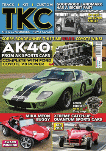
STEVE HOLE tells the story of the short-lived Huron Auto Race Developments, a real ‘one that should have been’ if ever there was one.
Kingston-on-Thames High Street was a hotbed of motorsport activity in the sixties. There was V.W. Derrington and TDC Components virtually next door. Opposite was a large Heron Service Station and behind that was the promising Huron Auto Race Developments operation set up in 1971 by Canadian businessman Jack Smith and his friend Roy Ireland along with Swiss designer Jo Marquart, ex-McLaren and GRD.
The team unveiled a sports racer in 1971 called the M4A and shortly after a Formula Atlantic single-seater called the Mk1A. There was also an F3 car the SS1E.
Sponsorship was forthcoming from the CAMEL tobacco brand, which was a good start. The company name, Huron, was taken from one of the Great Lakes in North America.
The original intention was to run the company from Huron, Ontario in Canada, but they decided on the UK, as that was where the vital suppliers were, like Jim Finch’s FKS who produced their GRP bodies.
The hugely talented Marquart was 34 in 1971 and had been chief designer of McLaren for three years, he’d originally worked for the Sauer diesel company and Hawker Siddeley before he joined Lotus to work on the Excel and Eclat projects.
He then joined McLaren where he designed some classic models like the Can-Am M8A big banger, the four-wheel drive M9A and the M14A F1 car of 1970. He also had a hand in the 1971 M19 F1 design before joining Huron.
Smith was the managing director … and his living was earned as a chartered surveyor and he was a keen motorsport enthusiast and club racer enjoying moderate access in Formula Libre in a Brabham-Climax.
Born in England, 40-year-old Roy Ireland handled PR and Sales. He’d previously worked for General Motors as a stylist and had designed all sorts of things from cutlery to white goods. He was also a GRP expert and he designed the bodywork for Huron’s cars working closely with the ‘other’ Jim Clark at FKS. He was also a keen club racer.
The company’s sheet metal and prototype work was done by BS Fabrications in Luton, run by ex-Team Lotus mechanics Bob Sparshott, Ron Chappell and John ‘Ace’ Waddington.
The Huron M4A sports racer used a Cosworth FVC, with rear-mounted radiators moulded into the doors. The monocoques were built by Grand Prix Metalcraft, the GRP by FKS and castings by Stirling Metals. Only two were produced.
The cars were beautifully built, Marquart was a top-class designer, so it was a surprise when they closed their doors in 1973. Various reasons have been suggested with the most plausible being that Camel withdrew their sponsorship money which left the team short of funds especially after Smith had died.
Jo Marquart described Huron as a story that should have been forgotten!








